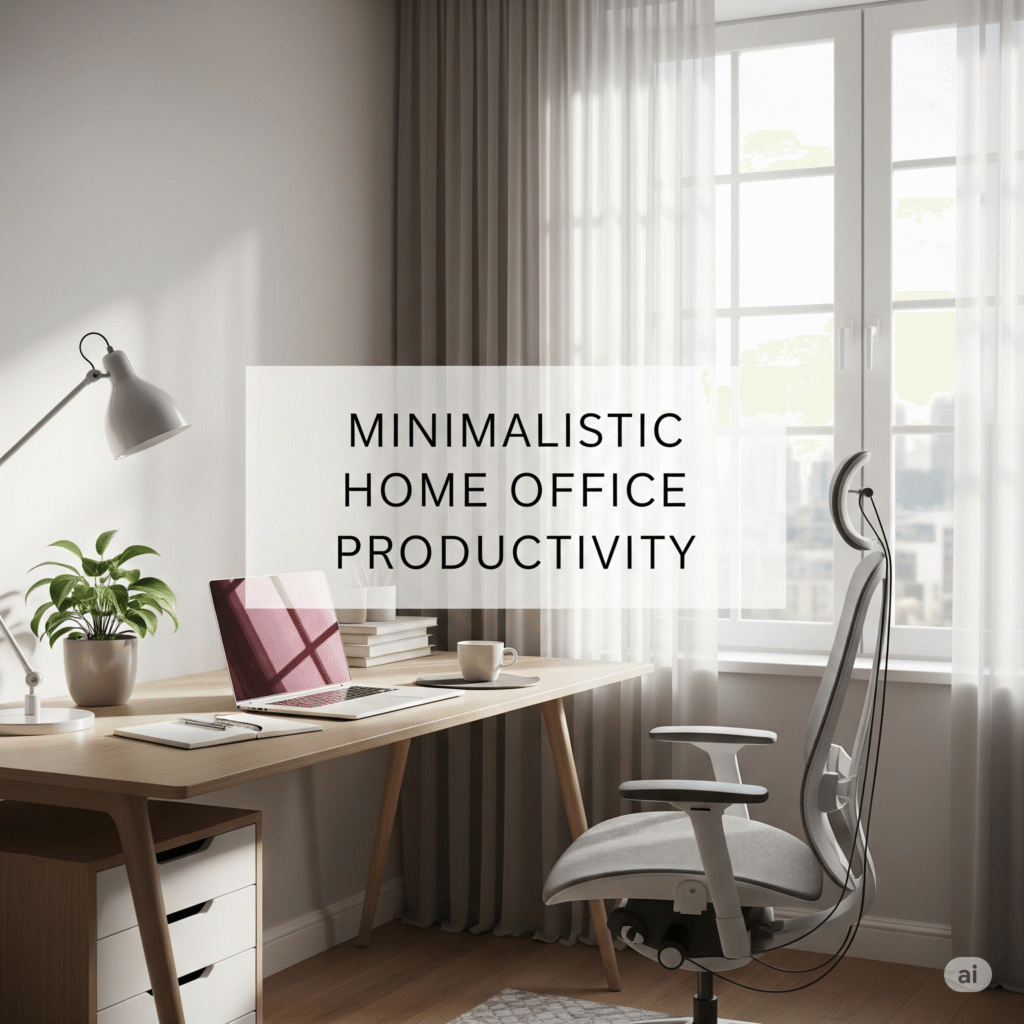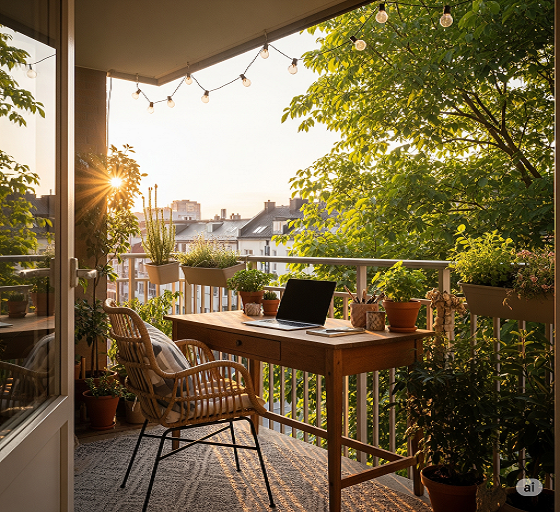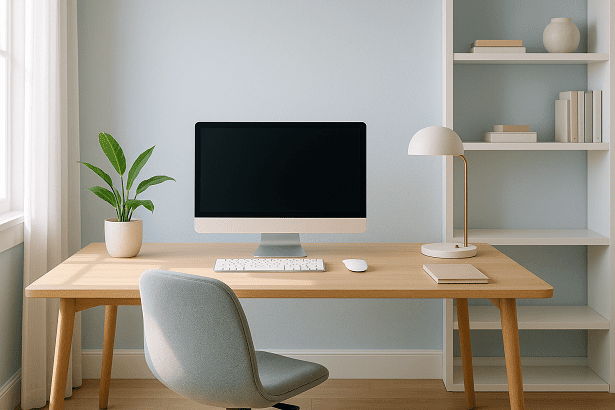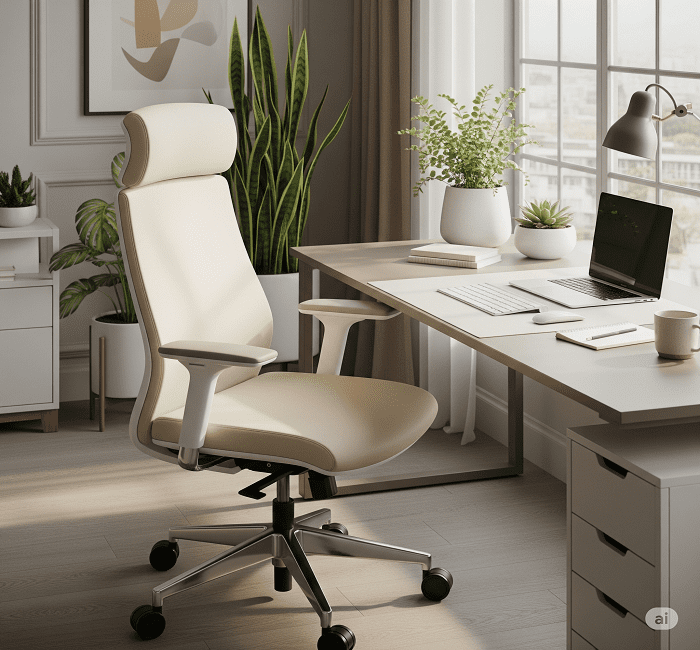Introduction
Ever feel like your workspace is working against you? Sticky notes everywhere, cables tangled under the desk, and a mountain of coffee cups fighting for space with your keyboard?
The truth is, cluttered spaces often lead to cluttered minds.

That’s where the power of minimalistic home office productivity comes in. By intentionally designing a clean, simplified workspace, you can reduce distractions, reclaim your focus, and actually enjoy working from home.
In this guide, you’ll learn how to transform your home office into a productivity sanctuary that supports deep work, reduces stress, and keeps you feeling in control. Whether you’re a remote professional, freelancer, or creative, this article will show you how to do more—with less.
What is Minimalistic Home Office Productivity and Why It Matters
Minimalistic home office productivity is the practice of using a clean, clutter-free, and purposefully designed workspace to boost focus, reduce mental fatigue, and improve work efficiency from home.
It’s not about empty desks or sterile rooms—it’s about intentional simplicity.
By removing visual noise and unnecessary items, you allow your brain to engage more fully in the task at hand. Research from Princeton University shows that physical clutter competes for your attention, making it harder to focus and increasing stress.
Minimalism in your workspace supports mental clarity, promotes organization, and fosters a calm environment—essential ingredients for staying productive in a remote setting.
Benefits of Minimalistic Home Office Productivity
1. Enhanced Focus
Fewer distractions mean fewer temptations to multitask. A minimal setup helps your mind zero in on what matters most.
2. Reduced Decision Fatigue
When your space is organized and intentional, you waste less time deciding what to do, where to sit, or how to start. Everything has its place.
3. Less Stress, More Calm
A tidy environment naturally lowers cortisol levels. The brain interprets clutter as unfinished business, which can lead to anxiety.
4. Improved Workflow Efficiency
You save time looking for documents, supplies, or your mouse beneath that pile of paper.
5. Visual Aesthetics & Creativity Boost
A minimal space isn’t just efficient—it’s inspiring. Clean lines and soft tones foster creativity and peace of mind.
According to a 2020 study published in Environment and Behavior, workers in minimalist environments reported higher job satisfaction and lower cognitive overload.
Common Mistakes or Misconceptions
Myth: Minimalism Means Cold and Uninviting
Wrong. Minimalism can be warm, personal, and cozy—it’s about intentionality, not sterility.
Mistake: Hiding Everything in Drawers
Minimalism isn’t just about hiding clutter—it’s about reducing it. Shoving things into a drawer doesn’t solve the underlying chaos.
Myth: You Need Expensive Furniture
Not at all. A minimalist office is more about mindset than money. You can achieve it with affordable IKEA pieces or even DIY setups.
Mistake: Getting Rid of Useful Items
Minimalism is about keeping what adds value to your day. If it serves a purpose or brings joy—it belongs.
Step-by-Step Implementation Guide
Step 1: Define Your Workspace Intentions
Ask: “What do I really need to work effectively?”
- A desk
- Comfortable chair
- Laptop/monitor
- Notebook and pen
- Lighting
- One or two personal items (e.g., a plant, a framed photo)
Step 2: Declutter Ruthlessly
Start with a purge:
- Toss anything you haven’t used in the last 30 days
- Remove duplicate or broken items
- Digitize paper where possible
- Keep only what you use weekly
Step 3: Invest in Clean, Functional Furniture
Choose:
- A compact desk with cable management
- Ergonomic chair with back support
- Minimalist wall shelf or drawer unit
Step 4: Organize for Accessibility
- Use a single drawer for essentials
- Add cable organizers to reduce wire clutter
- Label your files clearly or go digital
- Store infrequently used tools out of sight
Step 5: Embrace Digital Minimalism
- Unsubscribe from unnecessary notifications
- Close unused browser tabs
- Limit your workspace apps to 3–5 core tools
Step 6: Add a Touch of Personality
Minimal doesn’t mean boring. Add:
- A small plant (like a snake plant or succulent)
- A framed motivational quote
- One object that brings joy (e.g., a vintage clock or candle)
Step 7: Create a Reset Routine
Every evening:
- Tidy your desk
- Shut down your laptop
- Prepare tomorrow’s to-do list
A 10-minute reset keeps the space minimal without daily rework.
Recommended Tools, Templates, and Resources
Productivity Apps
- Notion – For minimalist digital planning
- Todoist – Clean interface for tasks and goals
- Forest App – Encourages focus with nature-inspired timer
- Freedom – Blocks distractions
Workspace Accessories
- Cable management box
- Under-desk drawer or pegboard
- Wireless keyboard & mouse
- Desk mat for aesthetic and function
Books & Frameworks
- Essentialism by Greg McKeown
- Digital Minimalism by Cal Newport
- The Life-Changing Magic of Tidying Up by Marie Kondo
Personal Insight or Case Study
When I moved into my first tiny apartment as a remote worker, my “office” was the corner of my bedroom. I had too much stuff and nowhere to put it.
I started by asking: what do I really need to do my best work? The answer was simple: my laptop, a notepad, a pen, and some quiet.
I donated half of what I owned, sold my bulky desk, and bought a sleek table that fit perfectly by the window. A single plant added life. I used Notion for planning and Forest to stay focused.
The result? My anxiety went down. My focus improved. And my home felt like a place I wanted to be in—even after logging off.
Minimalism wasn’t about sacrifice. It was about clarity.
FAQs
Q1: What’s the ideal color palette for a minimalist office?
Stick to neutrals—whites, grays, beiges, and light woods. Add a single accent color if desired.
Q2: How do I prevent my space from getting cluttered again?
Use the one-in, one-out rule: if you bring something new in, remove something old.
Q3: Can a minimalist setup work in shared or small spaces?
Yes. Use vertical space, compact furniture, and clearly define your work zone—even if it’s just a corner.
Q4: Is digital minimalism part of this?
Absolutely. Reduce tabs, notifications, and app overload to simplify both physical and digital distractions.
Q5: What if I love office decor and aesthetics?
You can still express yourself—just be intentional. One framed art piece or carefully selected accessories can elevate your space without cluttering it.
Conclusion and Call to Action
Creating a minimalistic home office productivity system isn’t about perfection—it’s about purpose.
By intentionally simplifying your space, you:
- Enhance your focus
- Lower your stress
- Improve your workflow
- Enjoy your workspace more
Small changes, like clearing your desk or switching to a calming color palette, can have a huge impact. Start with one step from this guide and build momentum.
Want more inspiration? Check out our related articles on How to Stay Productive when Working from Home, and Time Blocking for Productivity.



